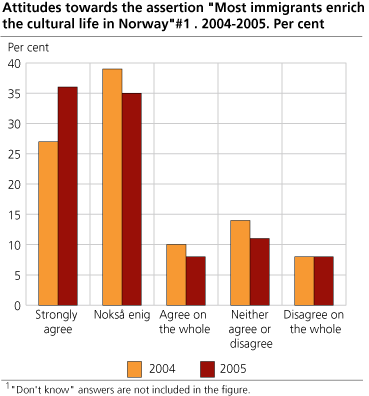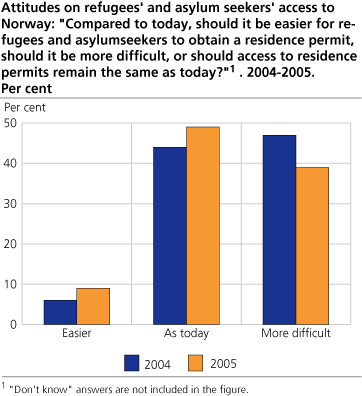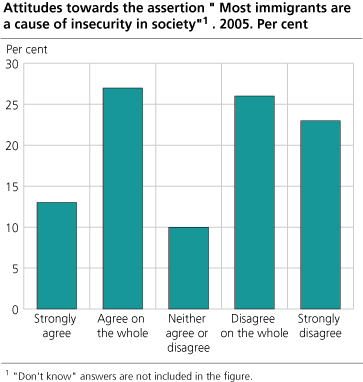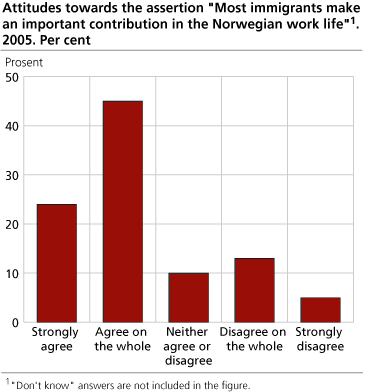Content
Published:
This is an archived release.
More positive attitudes towards immigrants
Attitudes towards immigrants and immigration were by and large somewhat more accepting last year. This appears in the last survey on attitudes towards immigrants and immigration conducted by Statistics Norway in 2005.
The proportion of people holding that it should be harder for refugees and asylum seekers to obtain permanent residence in Norway was reduced by 8 percentage points last year. The belief that immigrants enrich the cultural life in Norway increased by 5 percentage points last year, and the proportion thinking that immigrants generally abuse the social welfare system decreased by 4 percentage points. There was also a 3 percentage points increase in the proportion thinking that most immigrants contribute positively in the Norwegian work life.
Rising business cycles
Decreasing numbers of asylum seekers, combined with the effect of rising business cycles, is probably part of the explanation of these changes in attitudes. This also imply that negative incidents at high political level outside Norway in the month of July - during the collection of data, like the bomb attacks in the London metro and the attacks against hotels in Sharm el-Sheik in Egypt, did not influence the Norwegian opinion towards own immigrants.
People find immigrants enriching the society
According to the latest data seven out of ten hold that most immigrants make an important contribution in the Norwegian work life. At the same time half the population deny that immigrants abuse the system of social benefits. Regarding the assertion that immigrants represent a cause of insecurity in society, there is no change from last year. Still four out of ten believe that immigrants are a cause of insecurity, while five out of ten reject this idea.
The fact that the Norwegian population has an overall positive relationship to immigrants, is also demonstrated by the fact that nine out of ten would not mind having an immigrant as home help or new neighbour.
Only 6 per cent of the population admits that they would find this situation uncomfortable, a 3-4 percentage points' reduction from last year. Nine out of ten also hold that immigrants should have the same opportunities at the labour market as Norwegians. But one third is still negative to having a son-in-law or daughter-in-law with immigrant background.
Varying attitudes in the population
The attitudes towards immigrants and immigration vary in the population according to factors like age, educational level, place of residence and degree of contact with immigrants. Earlier surveys have also shown that political sympathies are of great importance for the attitudes.
Sex is a relatively unimportant factor, but there is a slight tendency towards women being more liberally attuned towards immigrants than men. Age is stronger related to the attitudes, and the oldest age group (67-79 years) manifests itself with the most sceptical and restrictive attitudes. The youngest age group (16-24 years) are sometimes among the most liberal, as in the question of whether immigrants should become as similar to Norwegians as possible and the question whether immigrants should be accepted as sons and daughters-in-law. However, regarding immigrants on the labour market, the young are less generous than young adults (25-44) and the middle-aged (45-66) who are well integrated in the labour market.
The educational level is most important
Education is the background factor influencing the attitudes towards immigrants and immigration the most. Highly educated people are systematically more positively attuned to immigrants and immigration than people with a low or intermediate education. While e.g. 20 per cent of the population with long university education thinks it should be easier for refugees and asylum seekers to obtain permanent residence in Norway, only 5 per cent of the population with basic education thinks the same.
Persons settled in densely populated areas with more than 100 000 inhabitants, i.e. in the larger cities with surroundings, are generally somewhat more liberal in their attitudes towards immigrants and immigration than persons in less urban districts of the country. For some indicators of attitudes the effect of place of residence is weakened or altogether removed when differences in educational level or the degree of social contact with immigrants are taken into account.
The degree of positive attitudes towards immigrants and immigration is above the mean in the counties of Akershus and Oslo. Eight out of ten in this region think that immigrants make an important contribution in the Norwegian work life, against seven out of ten for the whole country. Similar findings have been done several times before, but the differences between the regions of the country now seems to be somewhat smaller than before.
Social contact shapes attitudes
Persons having social contacts with immigrants have more liberal attitudes towards immigrants than persons lacking direct contact. The more arenas for the contact, the more accepting are the personal attitudes. The attitudes towards immigrants are also dependent on how many immigrants who are embraced by the contact. The more immigrants, the more positive are the attitudes.
Whether it is the contact that generates the positive attitudes, or the positive attitudes that leads to more immigrant contact, is unsolved. Probably both mechanisms work to produce the result.
Tables:
- Table 1 Attitudes towards six assertions on immigrants. 2002-2005. Per cent
- Table 2 Attitudes towards the assertion "All immigrants in Norway should have the same opportunities to have a job as Norwegians". 1993-2000 and 2000-2005. Per cent
- Table 3 Attitudes towards refugees access to the country. 2002-2005. Per cent
- Table 4 Answers to three questions on relation to immigrants. 2002-2005. Per cent
- Table 5 Contact with immigrants on different arenas. 2002-2005. Per cent
- Table 6 Number of arenas where contact with immigrants takes place. 2002-2005. Per cent
- Table 7 Number of immigrants one has contact with. 2003-2005. Per cent
Contact
-
Frøydis Strøm
E-mail: froydis.strom@ssb.no
tel.: (+47) 40 81 13 17
-
Christian Sørlien Molstad
E-mail: christian.molstad@ssb.no
tel.: (+47) 46 65 99 12




